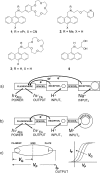Modification of fluorescent photoinduced electron transfer (PET) sensors/switches to produce molecular photo-ionic triode action
- PMID: 24574178
- PMCID: PMC4499248
- DOI: 10.1002/anie.201310939
Modification of fluorescent photoinduced electron transfer (PET) sensors/switches to produce molecular photo-ionic triode action
Abstract
The fluorophore-spacer1-receptor1-spacer2-receptor2 system (where receptor2 alone is photoredox-inactive) shows ionically tunable proton-induced fluorescence off-on switching, which is reminiscent of thermionic triode behavior. This also represents a new extension to modular switch systems based on photoinduced electron transfer (PET) towards the emulation of analogue electronic devices.
Keywords: electron transfer; fluorescence; molecular devices; molecular switches; triodes.
© 2014 The Authors. Published by Wiley-VCH Verlag GmbH & Co. KGaA. This is an open access article under the terms of the Creative Commons Attribution License, which permits use, distribution and reproduction in any medium, provided the original work is properly cited.
Figures


Similar articles
-
Phosphorescent pH sensors and switches with substitutionally tunable response range based on photo-induced electron transfer.Luminescence. 2005 Jul-Oct;20(4-5):339-46. doi: 10.1002/bio.832. Luminescence. 2005. PMID: 16134222
-
Anion sensing with luminescent quantum dots--a modular approach based on the Photoinduced Electron Transfer (PET) mechanism.J Fluoresc. 2008 Mar;18(2):527-32. doi: 10.1007/s10895-007-0295-9. Epub 2007 Dec 20. J Fluoresc. 2008. PMID: 18157738
-
Precise Proton Mapping near Ionic Micellar Membranes with Fluorescent Photoinduced-Electron-Transfer Sensors.Chemistry. 2019 Jun 26;25(36):8522-8527. doi: 10.1002/chem.201806270. Epub 2019 May 15. Chemistry. 2019. PMID: 30947361
-
Activity-Based Sensing and Theranostic Probes Based on Photoinduced Electron Transfer.Acc Chem Res. 2019 Oct 15;52(10):2818-2831. doi: 10.1021/acs.accounts.9b00340. Epub 2019 Sep 20. Acc Chem Res. 2019. PMID: 31538473 Review.
-
Fluorescence quenching by photoinduced electron transfer: a reporter for conformational dynamics of macromolecules.Chemphyschem. 2009 Jul 13;10(9-10):1389-98. doi: 10.1002/cphc.200900238. Chemphyschem. 2009. PMID: 19475638 Review.
Cited by
-
An Aggregation-Induced Emission-Based Indirect Competitive Immunoassay for Fluorescence "Turn-On" Detection of Drug Residues in Foodstuffs.Front Chem. 2019 Apr 24;7:228. doi: 10.3389/fchem.2019.00228. eCollection 2019. Front Chem. 2019. PMID: 31069213 Free PMC article.
-
A multi-stimuli responsive switch as a fluorescent molecular analogue of transistors.Chem Sci. 2016 Mar 1;7(3):1819-1825. doi: 10.1039/c5sc03395k. Epub 2015 Nov 19. Chem Sci. 2016. PMID: 28959394 Free PMC article.
References
-
- Valeur B, Berberan-Santos MN. Molecular Fluorescence. 2. Weinheim: Wiley-VCH; 2012. nd ed.
-
- Lackowicz JR. Principles of Fluorescence Spectroscopy. 3. New York: Springer; 2006. rd ed.
-
- L. Prodi, N. Zaccheroni, M. Montalti. Luminescence Applied in Sensor Science. Berlin: Springer; 2011.
-
- de Silva AP, Gunaratne HQN, Gunnlaugsson T, Huxley AJM, McCoy CP, Rademacher JT, Rice TE. Chem. Rev. 1997;97:1515–1566. - PubMed
-
- He H, Mortellaro M, Leiner MJP, Young ST, Fraatz RJ, Tusa J. Anal. Chem. 2003;75:549–555. - PubMed
Publication types
MeSH terms
LinkOut - more resources
Full Text Sources
Other Literature Sources

